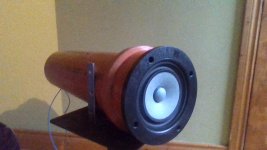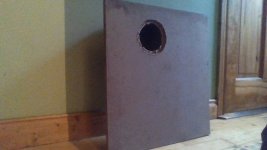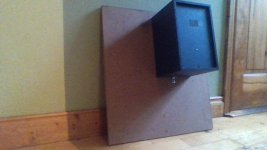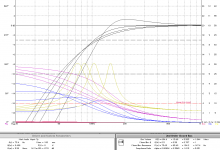I tried a few rough cabinet designs for the Alpair 7p running full range.
First an open baffle, where bass quantity/extension was only a slight problem compared to the sound lacking presence and body throught the whole frequency range, adding a woofer wouldnt have helped with that I dont think.
with such a disappointing baseline I wanted to try something different than try to improve the OB
To hear a sealed enclosure in the simplest way possible from there I added a small sealed box over the back of driver on the open baffle,
this actually sounded quite good.
As you can see in the photo the front baffle is hugely oversizely and there doesnt seem to be any benefit to that mentioned anywhere, .
Next they were put in some straight PVC pipe with roughly the same volume as the small box, either sealed or ported this sounded the worst of all.
Most of the pipe designs use an elbow joint for the driver with a vertical pipe,
I assume this is mostly for convenience or aesthetic reasons but I could imagine some sort of redirection is important considering the nature of TL designs, still having some straight pipe to start seems better to minimize reflections.
The possibility for designs and ease of remodelling with pipes is very appealing, but based on the intial impression not sure if its worth investing more time/money in.
Sticking to the baffle and box there are 2 directions it can go:
cut the large oversized baffle down to the same size as the sealed box or build a large sealed box to the size of baffle.
Not sure if box volume is that important for sealed design with FR driver, seems to be mostly to do with getting good extension out a of woofer.
First an open baffle, where bass quantity/extension was only a slight problem compared to the sound lacking presence and body throught the whole frequency range, adding a woofer wouldnt have helped with that I dont think.
with such a disappointing baseline I wanted to try something different than try to improve the OB
To hear a sealed enclosure in the simplest way possible from there I added a small sealed box over the back of driver on the open baffle,
this actually sounded quite good.
As you can see in the photo the front baffle is hugely oversizely and there doesnt seem to be any benefit to that mentioned anywhere, .
Next they were put in some straight PVC pipe with roughly the same volume as the small box, either sealed or ported this sounded the worst of all.
Most of the pipe designs use an elbow joint for the driver with a vertical pipe,
I assume this is mostly for convenience or aesthetic reasons but I could imagine some sort of redirection is important considering the nature of TL designs, still having some straight pipe to start seems better to minimize reflections.
The possibility for designs and ease of remodelling with pipes is very appealing, but based on the intial impression not sure if its worth investing more time/money in.
Sticking to the baffle and box there are 2 directions it can go:
cut the large oversized baffle down to the same size as the sealed box or build a large sealed box to the size of baffle.
Not sure if box volume is that important for sealed design with FR driver, seems to be mostly to do with getting good extension out a of woofer.
Attachments
What are your objectives and constraints for this system? The Alpair is a decent enough performer, but to squeeze the most juice needs either some bass assistance when used OB or in a very small sealed enclosure or TL, or a larger vented design of some sort if to be fullrange. There are numerous field tested designs for it, including FH3, Pensil (both floorstanders), or for a compact monitor whatever the name would be of the Planet10 CGR milli Mar-Ken.
Enclosure simulations have been around for decades. No need to go blind.
At the least , one could download WinISD or something similar and more recent and see first hand the effects of the size of the box with a particular driver.
Presence and body comes from the lower 100s Hz, and since on OB, I have a feeling that the MA driver will drop like a brick at 300 or 400 Hz, no wonder it feels lacking.
Cylinders, as you have found, are the worst shape for an enclosure. A short search would've yielded the answer.
We indeed have no idea of your expectations or music you plan on listening, but unless you plan to listen in near field, at reasonable to lower levels, then the little 7 will not have the most full bodied sound for sure.
For that, you'll need a FAST setup. The little 7 will need a woofer. For a good example, look at xrk971 FAST 10f with RS225. The XO would need to be tweaked probably since you would use the 7p instead of the 10f.
At the least , one could download WinISD or something similar and more recent and see first hand the effects of the size of the box with a particular driver.
Presence and body comes from the lower 100s Hz, and since on OB, I have a feeling that the MA driver will drop like a brick at 300 or 400 Hz, no wonder it feels lacking.
Cylinders, as you have found, are the worst shape for an enclosure. A short search would've yielded the answer.
We indeed have no idea of your expectations or music you plan on listening, but unless you plan to listen in near field, at reasonable to lower levels, then the little 7 will not have the most full bodied sound for sure.
For that, you'll need a FAST setup. The little 7 will need a woofer. For a good example, look at xrk971 FAST 10f with RS225. The XO would need to be tweaked probably since you would use the 7p instead of the 10f.
The objective is to get best sound possible out of single FR driver with the materials I have lying around, there is not much flexibility here so no point simulating.
A search of pipe enclosures (rather than cylindrical enclosures) did yield some positive reports, many people have done it, not sure why even if it is cheap/easy I also read cylinders are better for edge diffraction (although with this pipe there is no edge to speak of).
I also read cylinders are better for edge diffraction (although with this pipe there is no edge to speak of).
At this point I think I will just build a bigger box for the baffle, at least where bass is concerned the bigger box will help.
Really its a question is how box size will effect the rest of frequency range
A search of pipe enclosures (rather than cylindrical enclosures) did yield some positive reports, many people have done it, not sure why even if it is cheap/easy
At this point I think I will just build a bigger box for the baffle, at least where bass is concerned the bigger box will help.
Really its a question is how box size will effect the rest of frequency range
If the picture you posted is of your cylindrical enclosure, what you have implemented looks far too small.
A7p sealed will not go real low, if you want to get as much LF you will need to put them in a box with a hole — turk’s suggestion of FH3 is one of the best performers, but a reflex between 9-13 litres should do fine if you need a smaller box. If you are going sealed, you will need helper woofers if the LF extention is not satisfactory.
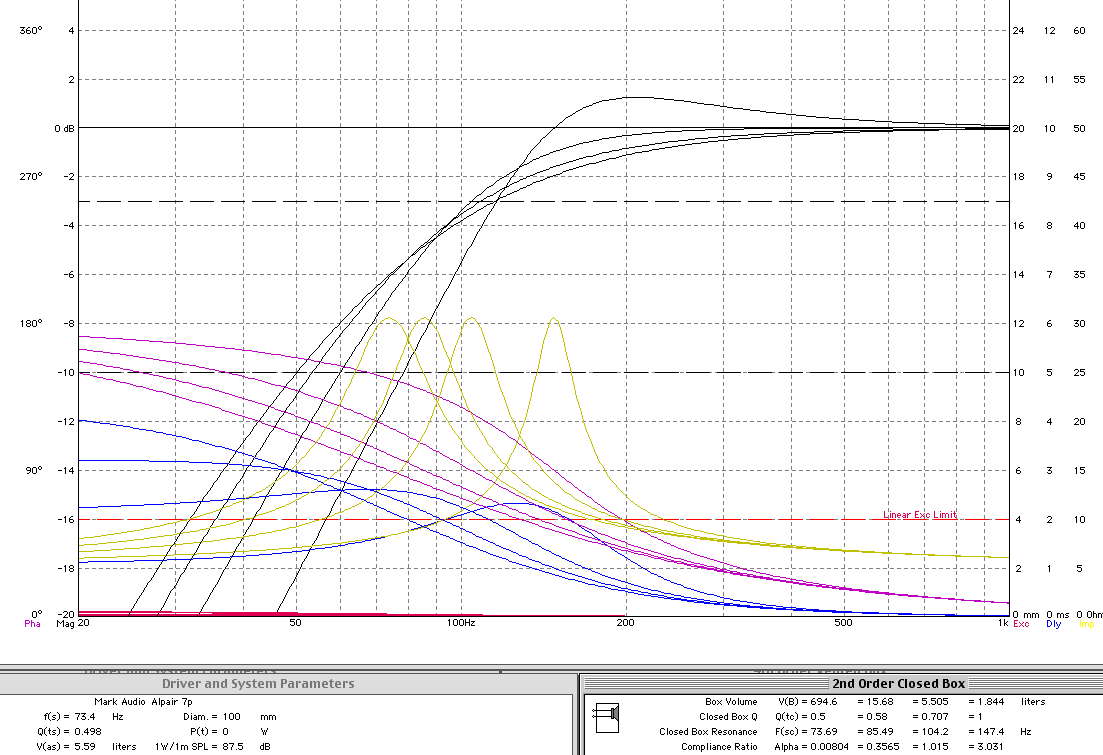
Sim suggests a sealed box volume of about 5 litre stuffed.
dave
A7p sealed will not go real low, if you want to get as much LF you will need to put them in a box with a hole — turk’s suggestion of FH3 is one of the best performers, but a reflex between 9-13 litres should do fine if you need a smaller box. If you are going sealed, you will need helper woofers if the LF extention is not satisfactory.
Sim suggests a sealed box volume of about 5 litre stuffed.
dave
Attachments
although there isnt much significant change in simulation beyond 5L those bigger boxes must sound completely different for an FR driver.
also using less stuffing or even none at all with some damping material on inner walls with a bigger box for same effective volume must also sound completely different.
Im guessing there really isnt any guideline on how best to approach it, as it depends mostly on driver, and the a7 is not a popular choice for sealed to begin with.
The wooden boards will need to cut down to size anyway, so im inclined to go bigger.
Is there a software similar to edge that will allow simulation of different box shapes and sizes for the full frequency range?
also using less stuffing or even none at all with some damping material on inner walls with a bigger box for same effective volume must also sound completely different.
Im guessing there really isnt any guideline on how best to approach it, as it depends mostly on driver, and the a7 is not a popular choice for sealed to begin with.
The wooden boards will need to cut down to size anyway, so im inclined to go bigger.
Is there a software similar to edge that will allow simulation of different box shapes and sizes for the full frequency range?
Eventually discovered that there was similar discussion in this thread: Really large enclosure to approximate infinite baffle
Last edited:
How well a driver works in an infinite baffle alll depends on the driver’s Q. To get any bass at all it should be >0.5 There is such a thing as too big a box. In the case of the A7p anything over about 600 litres will be too large. Given the exponential growth in box size, this same volume is not much different than a stuffed 20 litre box. And a FR box needs to be damped if sealed or a reflex. Stuff coming back thru the cone degrades performance.
And actual cabinet wall damping (as opposed to acoustic damping placed on the walls) can often be counterproductive.
dave
And actual cabinet wall damping (as opposed to acoustic damping placed on the walls) can often be counterproductive.
dave
ok, thanks for the help, ill report how it turns out.
images of '''speaker damping'' mostly shows material damping the walls of BR enclosures.
I assume you mean for sealed only?And actual cabinet wall damping (as opposed to acoustic damping placed on the walls) can often be counterproductive.
images of '''speaker damping'' mostly shows material damping the walls of BR enclosures.
The boxes are finished, pretty rough but will seal up the cracks with filler/tape.
As for damping you were 100% right, using light and fluffy duvet filler the box was lined which filled about 40% of the volume, comparing it to how it sounded with none at all the sound didnt change much, was worried it was all a waste of time but further stuffing to about 80% then 90% both gave much better results all round.
Bass is sounding pretty decent in good amounts but since the box isnt well sealed yet it could change a lot.
As for damping you were 100% right, using light and fluffy duvet filler the box was lined which filled about 40% of the volume, comparing it to how it sounded with none at all the sound didnt change much, was worried it was all a waste of time but further stuffing to about 80% then 90% both gave much better results all round.
Bass is sounding pretty decent in good amounts but since the box isnt well sealed yet it could change a lot.
For a few reasons the box I built was very large, only slightly less wide than the large baffle in the picture and about that same size in depth.
Mainly that it involved the least amount of cutting, using most of the clean pre-cut edges on the wooden boards made construction neat and quick.
Also so it could be built with a removable back panel, for conversion to U-frame open baffle, which this time had a much larger effective baffle size... this was worth a try but the thin/hollow sound didnt improve much and sounded worse than before with U-frame, U-frame is probably too deep.
They sound pretty good in these sealed boxes but the size is ridiculous... does anyone have an idea how narrowing the boxes will affect sound? I read it will help imaging, and because of depth and height I can go extremely narrow while still having tons of volume.
Mainly that it involved the least amount of cutting, using most of the clean pre-cut edges on the wooden boards made construction neat and quick.
Also so it could be built with a removable back panel, for conversion to U-frame open baffle, which this time had a much larger effective baffle size... this was worth a try but the thin/hollow sound didnt improve much and sounded worse than before with U-frame, U-frame is probably too deep.
They sound pretty good in these sealed boxes but the size is ridiculous... does anyone have an idea how narrowing the boxes will affect sound? I read it will help imaging, and because of depth and height I can go extremely narrow while still having tons of volume.
it's a radiating area reduction and will affect the baffle step frequency as in loss of bass below the frequency related to the baffle size, can be compensated for via x-over.They sound pretty good in these sealed boxes but the size is ridiculous... does anyone have an idea how narrowing the boxes will affect sound?
the imaging can be worse if diffraction from baffle edges comes out to play.I read it will help imaging, and because of depth and height I can go extremely narrow while still having tons of volume.
Last edited:
yeah, imaging is already very good with these and I trust the theory is the reason why, strangely the few subjective reports I seen all mentioned narrower imaging better but in all cases were comparing totally different speakers.it's a radiating area reduction and will affect the baffle step frequency as in loss of bass below the frequency related to the baffle size, can be compensated for via x-over.
the imaging can be worse if diffraction from baffle edges comes out to play.
so outside of rebuilding the same box with good ply instead of pine this is probably already a pretty good example of a sealed A7P.
One final report on sealed alpair 7,
Initially the box was sealed with silicone in some main areas but there were still leaks around, mainly from the edge of drivers and speaker cable hole.
Fully the sealng box at last (with possibly a few invisible hairline cracks still around) did not reduce the bass response or extension to my ears, but the quality of the bass and also overall sound improved very noticeably.
I think that the A7 drivers respond really well to sealed enclosure and IMO the quantity of bass is more than adequate, the quality is sublime. With some of the more complex enclosure designs available you can probably get equally as good sounding bass with more quantity, but I like to think it will probably not have the same tight/punchy character as the sealed design.
Initially the box was sealed with silicone in some main areas but there were still leaks around, mainly from the edge of drivers and speaker cable hole.
Fully the sealng box at last (with possibly a few invisible hairline cracks still around) did not reduce the bass response or extension to my ears, but the quality of the bass and also overall sound improved very noticeably.
I think that the A7 drivers respond really well to sealed enclosure and IMO the quantity of bass is more than adequate, the quality is sublime. With some of the more complex enclosure designs available you can probably get equally as good sounding bass with more quantity, but I like to think it will probably not have the same tight/punchy character as the sealed design.
- Status
- This old topic is closed. If you want to reopen this topic, contact a moderator using the "Report Post" button.
- Home
- Loudspeakers
- Full Range
- sugggestions for next enclosure development?
